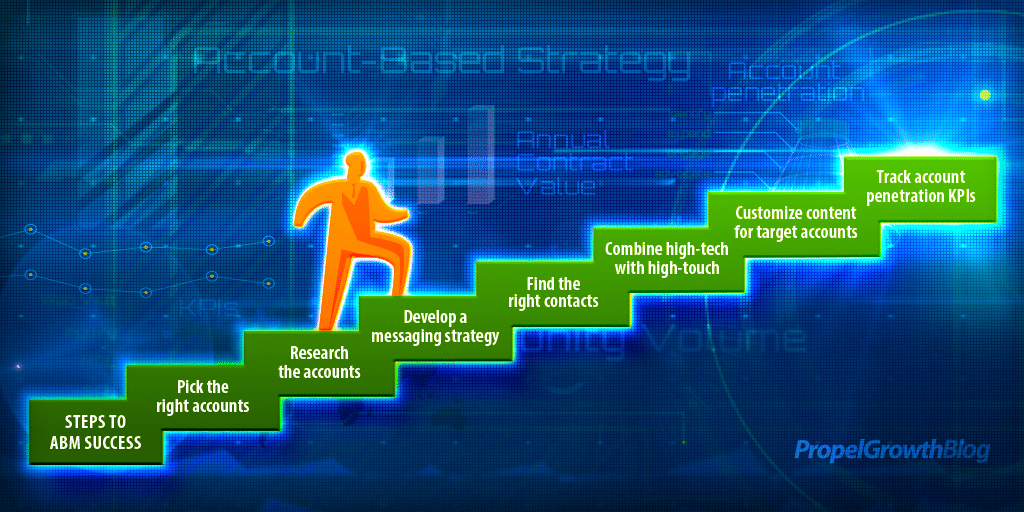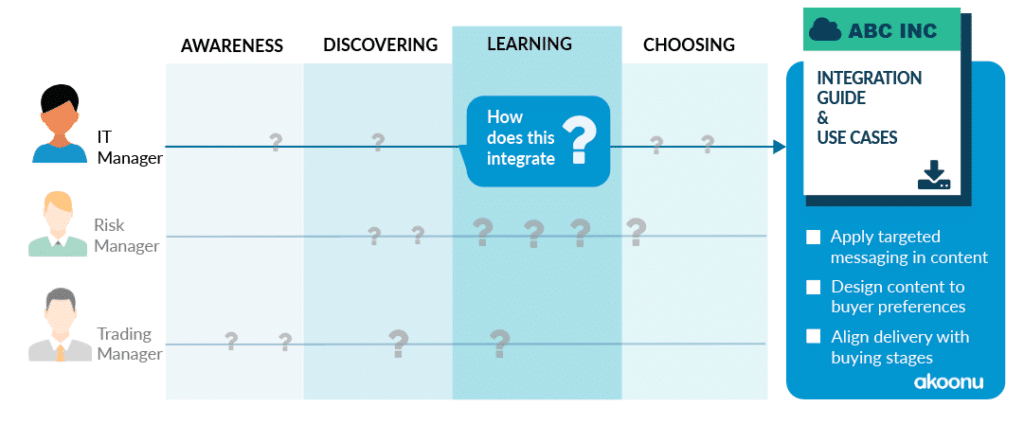
Account Based Marketing and Account Based Selling can create a substantial uplift in annual contract value (ACV) for large, strategic accounts. TOPO research found that when firms target specific accounts that meet an ideal customer profile, they see a 171% uplift in ACV. So how do you implement an account-based marketing strategy?
(Not familiar with ABM? Read: “What is an ABM Strategy?“)
ABM for Large Accounts and Small Addressable Markets
Account-based marketing (ABM) is a strategy that is best suited for the following situations:
- Accounts with a potential annual contract value (ACV) above $500K. Winning these accounts is worth the investment. Generally, these customers also expect more specialized knowledge from their vendors and expect an account-based focus.
- Accounts have a high average lifetime customer value (LCV). In this case, account expansion and retention is essential to your success.
- Small addressable market. If your firm has a small addressable market, then you can’t afford to churn through leads to meet sales goals. You have to win a significant percentage of the market to meet business goals.
- Must-win strategic accounts. If you have target accounts that you MUST penetrate in order to succeed, then an account-based strategy makes sense for those strategic targets.
Read more about whether an account-based strategy is right for your company.
Inbound Marketing Alone Won’t Work
Marketing to the masses (or even your target segment) doesn’t generally deliver the level of account penetration you need to sell to large accounts for two reasons.
- Your content needs to be broadly applicable across accounts that might discover it.
- Your inbound strategies are likely to attract those people in an account who are doing online research. Rarely do these people have authority to drive a $500K purchase decision.
Large, Strategic Purchases Require Trust
Rarely does a company make a choice exclusively based on product features when making a strategic investment of $500K or more.
- They choose the vendor that did the best job selling and making the prospect feel secure and comfortable with their decision.
- They choose based on confidence that the vendor and product will help them achieve company and personal goals.
- They choose the vendor that gives them the most confidence that the project will not fail.
An account-based selling approach helps build confidence in the buying committee. It’s about convincing them that your organization can be trusted. Accomplishing this demands an account-focused strategy.
Marketing-Enabled Target Account Selling
ABM isn’t about you – it’s about what’s important to the customer. So a true, Tier 1 ABM strategy demands investment into research about the target account. Identify their key initiatives. Figure out where they might be running into challenges, based on your internal experience with other accounts and information you can uncover about this specific account. Then determine what your firm can offer to help that initiative. This is how you develop the account strategy. You’re effectively taking strategic, target account sales tactics and enabling them with marketing.
There is a lot of noise around technology-enabled ABM. These systems support delivery. But the hard part of ABM is selecting the right accounts, finding the right message, and finding the right people to target.
In ABM, Research is Not Optional
Account-based marketing takes a commitment in time, money, focus, and attention. Many firms balk at the amount of research and custom work needed to enable an ABM strategy. But the research is not optional if you want to win the target account. If your team is not willing to do the necessary research, then I’d recommend a niche marketing strategy instead.
Someone has to do the research. It can be Marketing, Sales, Inside Sales or BDRs; but the person doing the research needs to have in-depth knowledge about how your firm has helped other similar accounts. Don’t assign a junior person to this task.
The researchers need to have a grasp on what kinds of initiatives and business needs to look for as they dig into the account. They need to know the typical organizational structure in similar accounts so they can identify the right target contacts. They need a grasp on how this structure diverges across different firms. This is especially important in financial services, where you’ll be targeting specific departments and business functions that are not consistently defined across different firms. Titles are particularly deceiving in the financial vertical.
Assume that you’ll need to invest at least 8-10 hours of research per account to develop an effective account strategy. Once it’s done, a team including someone from Marketing, Sales, and the BDR team should collaborate to come up with an account strategy. Document the strategy so everyone knows the plan. A plan should include a variety of touches over time targeting all of the relevant buyer personas in the target account.
Develop the Messaging Strategy
Once you have an overall account strategy, you’ll need to customize it to the needs of each buyer persona. Create your buyer personas first. Then develop message maps for each persona at each stage in the funnel. The message map should include questions that the persona is likely to ask at each stage and objections they’re likely to bring up.
Acquire the Right Contacts
Account-based marketing will only work if you have the contact information you need. There are many sources to help you obtain lists, and you’ll probably need to use more than one to get all the contacts needed. Make sure you have sufficient coverage in the account. This is crucial to your ABM strategy.
Create a High Touch/High Tech Outreach Plan
Firms experiencing the most success with ABM are creating strategies that include a mix of marketing and sales plays. These include:
- Account profiling
- Digital targeting (via social advertising targeting specific accounts/titles and ads targeting IP addresses)
- Appointment setting services
- Direct mail
- Custom content (in the form of research, assessments, infographics, videos)
- Customized landing pages (displayed based on the IP address of the visitor or a clicked link in an ad or email)
- Custom online events (webinars customized for a few target accounts)
- Live events (hospitality events at conferences, closed door round tables)
- Executive and peer-to-peer outreach
- Executive briefings
Develop Content Specific to the Target Accounts
Once the research is done, the account strategy down on paper, and the messaging maps developed, the content needs will probably be obvious. You’ll need to create some custom content that is specific for the account. But you’ll also be able to repurpose existing content.
Firms deploying ABM models are seeing a substantial increase in effectiveness when they customize the “wrapper” around content while leaving the internal content essentially the same. Consider making 20% of the content custom to the accounts. For example, write a custom executive summary and conclusion for a paper or report. Prepare email campaigns that include 20% custom content at the top specific to the target accounts. Link those emails to customize landing pages that include copy for specific accounts.
The magazine ABM in Action has some great case studies on how firms are deploying ABM.
Metrics to Track
The metrics for ABM are different than the metrics for traditional or inbound marketing strategies. Your focus should be engagement across the account, rather than net new leads. In fact, if you’re targeting key accounts, it’s highly unlikely that marketing will be the originating source for any of these leads. So traditional attribution models are not worthwhile.
Here are some KPIs to consider:
- Coverage: Do you have the right contacts at the key accounts? Is the coverage sufficient? Is it growing?
- Awareness: Do your target accounts demonstrate awareness? Are they visiting your site (even anonymously)? Are you seeing the anonymous traffic from that account increasing?
- Conversions: Are you converting traffic from the account into known contacts?
- Permission: Do you have opt-in permission from the contacts? Is the ratio of opt-ins growing?
- Engagement: Are the contacts you need engaging (track both offline and online engagement)? Breadth of engagement across the account is usually more valuable than depth of engagement with only 1-2 contacts.
- People: Are the right people at the account spending time with your company? Is it going up?
- Appointments: Is Sales finding it easier to get appointments in the target account?
Using LinkedIn to Supercharge ABM
In 2018, we started using LinkedIn to prospect for accounts in a market where we had no existing network. We’ve had some amazing success. Over the course of 6 months, a single sales person was able to connect with 500 new prospects, engage with 355, and book sales meetings with 125.
In addition, we’ve been able to improve close ratios by targeting and establishing relationships with multiple members of the buying committee.
Here’s how our lead conversion rates broke down for each phase in the process:
- Connection request to accepted connection: 76%
- New connections who engaged via LinkedIn messenger: 71%
- Connections who booked an initial Zoom call to get acquainted: 25%
- Initial meetings to qualified lead: 21.6%
Want to duplicate our process to get similar results for your business? We’ve recently launched a LinkedIn master class to show you exactly what we did.
How would 125 new sales calls for each of your reps in the next 6 months affect your pipeline? Would it help meet your revenue goals? Watch a free webinar to learn more, and if you think it would help, enroll in our master class.
8 Key Steps to Implement ABM
So to wrap it up – here are the key steps you need to deploy an account-based marketing approach:
- Pick the right accounts.
- Focus on marketing-enabled target account selling.
- Do the research needed to get deep knowledge about the accounts.
- Develop an account-specific messaging strategy.
- Find the right contacts.
- Design a high-touch/high-tech marketing plan.
- Create content that is customized for the target accounts.
- Track KPIs that will accurately gauge your account penetration.
More Info On Account-Based Marketing
Master Class: Using LinkedIn to Supercharge Account Prospecting
Free Webinar: Supercharge Account Prospecting Using LinkedIn
Article: Is Account-Based Marketing Right for Your Company?
Article: Account-Based Marketing for Investment Management Marketers
Article: Account-Based Selling and How It Can Help Your Sales Team
Guest Post: Five Levels of Account-Based Orchestration
Guest Post: How to Plan and Scale Account Based Marketing Interactions
Podcast: An Ideal Customer Profile with Craig Rosenberg
Podcast: Scaling Up Sales Growth with Account-Based Strategies
Related Content
An Ideal Customer Profile with Craig Rosenberg – Episode 002
- 4 Steps to Optimize Your LinkedIn Profile for Sales Prospecting – February 12, 2021
- The Reality of Cold Calling for B2B Sales – January 11, 2021
- Can Inbound Marketing Generate Enough Leads? – January 9, 2021







